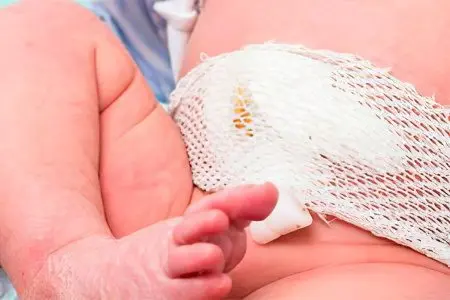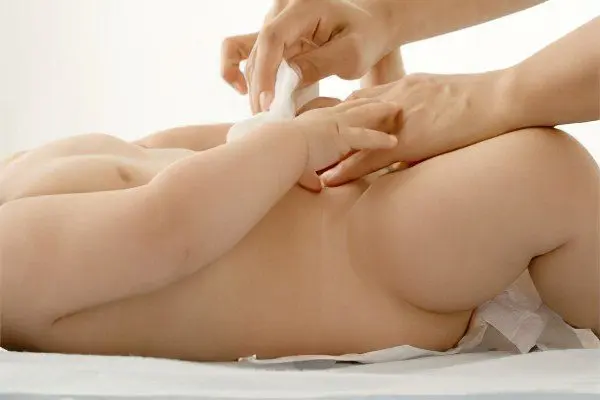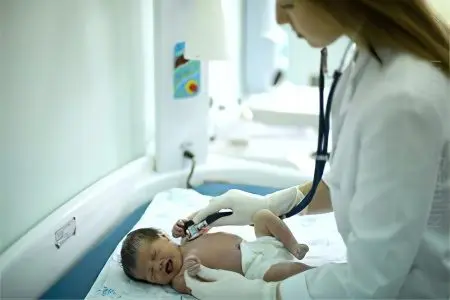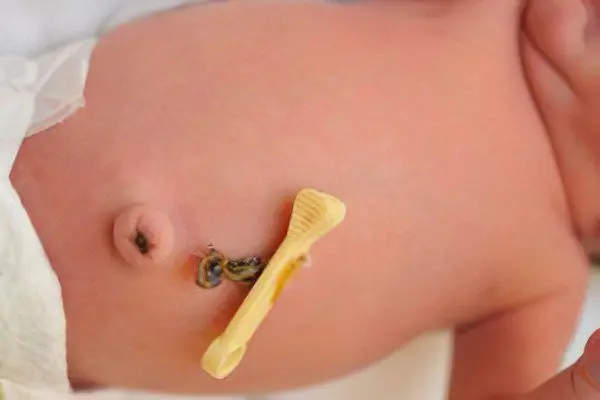Contents

Immediately after birth, a deep wound is formed at the site of cutting off the umbilical canal. In a healthy child, it overgrows very quickly, and the crust that forms on the navel disappears on the 5-6th day of life, leaving no trace. If, after the umbilical stump falls off, the navel is a weeping wound, it is possible that an umbilical fistula has formed in the newborn.
An umbilical fistula is a pathological formation in the form of a channel between the surface of the abdomen and the bladder or small intestine. The fistula canal is a vitelline or urinary duct that has not closed during fetal development. Normally, these ducts function as part of the umbilical cord, starting from the first weeks of fetal life. They provide nutrition to the fetus. The ducts fully perform their function until 3-5 months of pregnancy and then undergo obliteration.
If for some reason the infection of the vitelline or urinary duct did not occur, after the birth of the child, a vesico-umbilical or entero-umbilical fistula of the newborn is diagnosed.
How does an umbilical fistula manifest itself?

There are complete and incomplete forms of pathology, depending on the degree of openness of the vitelline duct:
Complete umbilical fistula – the duct is not completely overgrown, it is completely open and is connected directly to the bladder or to the small intestine.
Incomplete umbilical fistula – the duct in this case underwent partial obliteration, there is increased humidity in the navel, but there is no urine and feces.
With a complete umbilical-intestinal fistula of newborns, feces are excreted from the navel. The child loses weight and becomes noticeably thinner. This condition is dangerous for the development of intestinal obstruction and is an indication for urgent surgery.
With a complete umbilical-vesical fistula of newborns, urine is excreted from the fistulous tract. If the baby is relaxed and calm, urine is excreted in the form of a few drops. During straining and straining (for example, during crying), a trickle of urine is released from the navel. Through a wide umbilical-vesical fistula, the entire volume of urine can stand out.
Symptoms of an umbilical fistula
The manifestations of the disease vary depending on the type of pathology.
Symptoms of a complete umbilical-vesical fistula:
At the bottom of the navel, a bright red mucous membrane of the duct is noticeable;
Urine comes out of the navel;
From constant secretions, the skin near the navel is irritated and macerated.
If a urinary duct cyst joins the pathology, a painful tumor is detected on palpation of the anterior abdominal wall.
Symptoms of a complete umbilical-intestinal fistula:
At the bottom of the navel, a bright red mucous membrane of the duct is noticeable;
Feces are excreted from the navel;
The skin is swollen and macerated from exposure to intestinal secretions;
Through a wide fistula, part of the small intestine may fall out.
Symptoms of an incomplete umbilical fistula:
The navel looks like a corolla of the intestinal mucosa;
The tissues of the navel underwent granulomatous changes;
A foul-smelling liquid or mucopurulent discharge comes out of the navel.
Diagnostics

To clarify the diagnosis, the following diagnostic methods are used:
Ultrasonography of the umbilical cord in the area of the anterior wall of the peritoneum;
Ultrasound of the abdominal cavity;
The introduction of a contrast agent (methylene blue) into the umbilical fistula – if the contrast agent appeared in the bladder, then there is a complete umbilical-vesical fistula;
X-ray with a contrast agent (fistulography) to differentiate the complete and incomplete forms of the fistula;
Probing of the umbilical canal – inserting the probe more than 2 cm confirms the diagnosis.
Complications

If the pathology is complicated by the appearance of a cyst of the vitelline duct, there is a high risk of infection of the latter with the development of peritonitis as a result of rupture of the festering formation.
Other complications:
Formation of a hernia;
Obstructive intestinal obstruction;
Intestinal volvulus;
Infection of the umbilical fistula.
An incomplete fistula can be complicated by the development of omphalitis, an inflammatory process in the tissues of the navel.
Treatment of umbilical fistula
Incomplete umbilical fistula can be cured with conservative therapy. With properly selected treatment and careful observance of hygienic measures for the care of the baby, the umbilical fistula is finally tightened by the age of 6 months.
If there is no purulent discharge, the navel is treated at home, for this they use:
Zelenka;
Hydrogen peroxide;
Ointment Baneocin;
A complete umbilical fistula poses a danger to the life of the newborn, so surgical treatment is carried out immediately. Under general anesthesia, the surgeon removes the embryonic remnants of the vitelline duct. Tactics of treatment of umbilical-vesical fistula is to isolate the urinary duct and its further destruction.
Secondary prevention
Even carefully conducted treatment cannot guarantee protection against the occurrence of relapses of the disease. To prevent this from happening, it is necessary to exclude the possibility of constipation in a child, strictly observe the hygiene of the umbilical wound, and perform special exercises to strengthen the muscles of the peritoneum.










aperatsiyadan kiyin butunlay tuzaladimi aperatsiyani xaflilik darajasini ayting xafsiz aperatsiyaga kiradimi